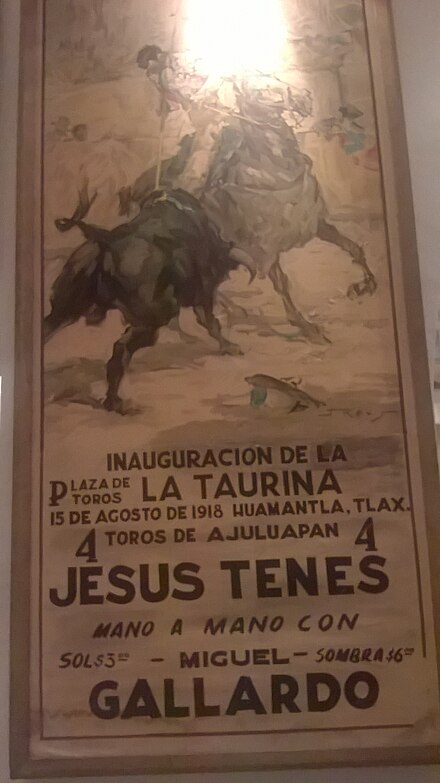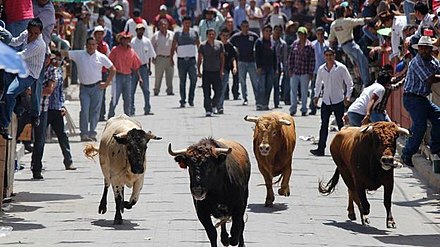Huamantla - Small city in the eastern half of the Mexican state of Tlaxcala

Huamantla is a popular weekend destination among residents of Mexico City who come for the colonial downtown area and the variety of cultural events, including the Feria Huamantla -- a celebration of Our Lady of Charity featuring a night on which residents create a 6 km long carpet in the city streets, and the annual "Huamantlada", an aderenaline rushing running of the bulls through the city streets, similar to the famous event held in Pamplona, Spain. Huamantla is a designated Pueblo Magico.
Understand
This region of Tlaxcala was the domain of the Otomi people before the arrival of Spanish conquistadors. The Otomi were largely agrarian and did not have an established settlement. Huamantla was founded in 1534. It was the site of a battle in 1847 that pitted elements of Santa Anna's army against elements of the U.S. army under the command of Gen. Joseph Lane. During the Reform era, it was designated as the state capital of Tlaxcala from 1858 to 1863.
Get in
Huamantla is located about 100 miles east of Mexico City, on highway MEX 136. The easiest way to get there is to fly to Mexico City and then take a bus.
Buses to Huamantla leave Mexico City from TAPO (Terminal Autobuses Poniente). Suprabus operates direct first-class buses every hour. Tickets cost M$158 and the ride takes 2 hours, 15 minutes.
From Puebla, bus service is provided by Suprabus or ADO. The trip is almost 4 hours and requires changing buses in Apizaco.
Get around
Huamantla is a small city and while walking is the best way to get around the Centro, you'll probably want a taxi to fully explore the city's attractions.
See
- Parque Juárez is the town square. It's a pleasant place to sit and people watch under towering shade trees. The neoclassical Palacio Municipal (city hall) faces the park as do a number of 18th and 19th century buildings.
- Parroquia de San Luis Obispo - The church and monastery were built between 1567 and 1585. It is a grey stone structure with white stucco bell towers. The exterior is simple, but the interior has more elaborate architectural elements with churrigueresque altars of gold, a number of alabaster statues in the main portal, and colonial era paintings throughout the church and monastery. The oldest paintings are in the Third Order chapel.

-
Museo Nacional de Titeres (National Puppet Museum) - Puppetry is a revered craft in Huamantla, where the Rosete Aranda family founded a popular traveling puppet show that performed throughout Mexico for more than a century. The Puppet Museum is in a mansion facing Parque Juarez in the city center. Eight exhibit halls showcase puppets, sets, and related objects from Mexico as well as from European and Asian puppeteers.
-
Museo Taurino Huamantla (Bullfighting Museum) - Bullfighting has a long and storied tradition in Huamantla and this 2-story museum located next to the bullfighting arena showcases the long and bloody hispanic tradition of bullfighting. See the different types of swords used in the ring, capes, matador outfits, model bullrings from other parts of Mexico, and posters advertising past bullfights.
-
Ranch Tours - Tour operators in Huamantla offer tours of the ranches where fighting bulls are raised and kept. Tlaxcala is home to Mexico's most storied bulls, and you can see the paddocks and fields where the bulls are born, trained, and live in preparation for the day they'll be the star of the bullring until their inevitable demise at the blade of the matador. Bull ranches near Huamantla include Rancho Seco, Ganaderia el Grullo, and Hacienda la Laguna.
Do
 The annual Feria de Huamantla is a 2-week celebration to give thanks to Our Lady of Charity (also known as the Virgin of the Asuncion) that takes place in August each year. The fair has been an annual event since 1870. The most famous part of it is the Night Nobody Sleeps when locals create miles of colorful carpets, called tapetes, in the city streets.
The annual Feria de Huamantla is a 2-week celebration to give thanks to Our Lady of Charity (also known as the Virgin of the Asuncion) that takes place in August each year. The fair has been an annual event since 1870. The most famous part of it is the Night Nobody Sleeps when locals create miles of colorful carpets, called tapetes, in the city streets.
- Night Nobody Sleeps - designs can be fanciful, imaginitive, or dignified and reflective. Each family or artist designs their own carpet panel. On the Night Nobody Sleeps, they sketch it out on the street in a designated frame which is carefully filled with pre-colored sawdust or paper shreds. Tinsel, sparkles and paper adornments are added to flesh out the design. For several hours, the carpets are left undisturbed while people walk the streets, admiring their craftsmanship. Then the parade starts with the procession of the Virgen of the Asuncion. Months of preparation and hours of work disappear as the parade proceeds to trample the carpets.

-
La Huamantlada - In a tradition similar to the running of the bulls in Pamplona, Spain, the city of Huamantla lets loose 20 bulls to run through the streets chasing any humans arrogant (or stupid) enough to try outrunning a half ton of angry beef. For more than 50 years, La Huamantlada has been a highlight of the town's annual Feria Huamantla. Visit Huamantla in August and you could try outrunning a bull too....or you could go up on the roof and watch, like the city's saner residents do. Bleachers are set up behind makeshift walls and vendors walk the streets selling peanuts, pulque, and plastic bull horns you can strap to your head for the occasion. The city has tamed down the event in recent years, limiting the number of bulls that run at a time or in an area, and using smaller bulls, but still, dozens are injured each year and deaths occur from being gored or trampled. It's great funǃ
-
La Malinche National Park - near Huamantlada, near the border with Puebla, is the 4,462 meter high volcano called La Malinche. It is popular with nature lovers and with beginner mountaineers, learning the ropes of climbing.
Buy
Eat
- La Plazuela, Hidalgo Pte 404, Centro, 19.313589°, -97.926835°, +522474720964. 09ː00 - 19ː00. Traditional casual patio restaurant with good food and low prices. 2023-01-31
- Tortas Gaby, Abasolo Ote. 201, Centro, 19.316825°, -97.919309°, +522471399330. 09ː00 - 21ː00. Huge freshly made sandwiches. Milanesa is the house specialty, stuffed with potatoes. 2023-01-31
- Cafe La Gloria, Carr. Lib. Carr. México-Veracruz 802, San Sebastián, 19.316583°, -97.908952°, +522476882947. 08ː00 - 22ː00. Modern, clean, family-friendly restaurant with kids play area. Good breakfast menu, large portions. 2023-01-31
- La Magia del Jardín Añoranza, C. Allende Sur 309, Centro, 19.310176°, -97.920224°, +522471004593. 08ː30 - 20ː00. Good atmosphere with traditional decor, comfortable and casual. Extensive menu with wider range than most area restaurants. Traditional Central Mexican dishes like chiles nogadas and sopa azteca. Outdoor dining area that's dog friendly. 2023-01-31
- Xnipac, Reforma Nte 302, Centro, 19.316591°, -97.923932°, +522471243822. 08ː00 - 20ː00. Small family restaurant. Known for their cochinita pibil and guisadas. 2023-01-31
Drink
- Cantaritos, México-Veracruz Boulebart Juan Pablo II, s/n, 19.304126°, -97.920546°. Casual bar, beer and mixed drinks. 2023-01-31
- La Pasadita, Negrete Ote. 116, Centro, 19.309458°, -97.920245°. 16ː00 - 05ː00. Cantina with DJ. 2023-01-31
Sleep
Budget
- Hostal de Dulce Nombre, Del Santuario 308A, Centro, 19.318234°, -97.917191°, +52 2474721771. Check-in: 15ː00, check-out: 12ː00. Cozy hostel with spacious rooms, limited services (no off-street parking). M$1000 (January 2023) 2023-01-31
- Hotel Azucena, Zaragoza Ote. 203 A, Centro, 19.314187°, -97.919518°, +52 2474724019. Check-in: 15ː00, check-out: 12ː00. Clean, comfortable hotel. Off-street parking. Steam baths (sauna). M$540 (January 2023) 2023-01-31
- Motel Sol y Luna, Xicohtencatl 12, Siglo XXI, Centro, 19.319414°, -97.935825°. Check-in: 15ː00, check-out: 12ː00. Very cheap barebones hotel on main highway. M$150 2023-01-31
Moderate
- La Aurora Hotel Boutique, Priv. San Francisco 4, Centro, 19.311504°, -97.924625°, +522471024030. Check-in: 15ː00, check-out: 12ː00. Very clean, well maintained property with comfortable rooms and friendly service. Quiet location. No breakfast. M$810 2023-01-31
Splurge
- Hacienda Soltepec, Carr. Huamantla - Puebla Km. 3, 19.288221°, -97.918993°, +52 2474721466. Check-in: 15ː00, check-out: 12ː00. Ideal choice for a romantic weekend getaway, the place is a former hacienda that looks like an enormous castle (complete with turrets). Rooms are spacious, clean, and comfortable with rustic decor (timbered ceilings, wood floors, etc.). Manicured gardens and courtyard restaurant. Golf course. M$2100 (January 2023) 2023-01-31
Go next
Huamantla
huamantla.gob.mxDate Time:Please wait...Timezone:America/Mexico_CityPopulation:51,996Coordinates:19.31, -97.93
Huamantla
2nd-order administrative division
Tlaxcala
Primary administrative division
